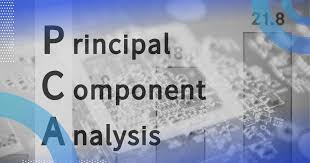The principal component analysis is a very popular technique that uses a large number of data sets by deconstructing the variance of multiple variables into its common components. In this piece, we will explain everything about Principal component analysis in R, Sklearn, and Python. Let’s drive!
Principal Component Analysis
The principal component analysis(PCA) is a very rampart technique for analyzing large datasets that contains a high number of dimensions or features per observation and also increases the interpretability of data while maintaining the maximum rate of information and enabling the visualization of multidimensional data. Formally, this technique is used for reducing the dimensionality of a dataset.
In addition, the PCA was invented in the year 1901 by Karl Pearson as an analog of the principal axis theorem in mechanics. In the 1930s it was independently named and developed by Harold Hotelling.
Why and When to Make Use of the PCA
- When the dimensions of the input variables or features are very high.
- The principle component analysis is basically for data compression
- It is a powerful tool for denoising.
- It is also particularly useful for the process of data where multi-colinearity exists between variables and features.
- To interpret and visualize data.
Objective of PCA
- One of its objectives is to find or identify patterns and the relationship between variables that may not be visible in the original data.
- It is basically for extracting features from a set of variables that are literally more relevant than the original variables. These features can then be used for other tasks and for modeling as well.
- It is a tool for compressing datasets by decreasing the total amount of variables needed to present the data while retaining more data as possible.
- The principle components analysis is for visualizing high-dimensional data in a lower-dimensional space. Thereby, making it more comprehensive
- It reduces noise in a dataset.
Limitations of a PCA
- Costly to compute. In other words, it has computing complexities.
- It may result in the loss of crucial information and data.
- Scaled and centralized data.
- Harder to identify some crucial characteristics of variables sometimes.
- Principal components analysis is not always simple to comprehend or describe in terms of the main or original features.
Where Is PCA Used?
The principal analysis is one of the most popular multivariate statistical analyses in the world today. Also, it is known as the unsupervised dimensionality reduction technique that constructs variables or features through linear or non-linear combinations of the original variables and features.
How Do You Interpret Principal Component Analysis?
To be able to interpret the principal components analysis very well, you must compute the correlation between each principal component and the original data, and this correlation is obtained from the use of the correlation procedures. In addition, to interpret the principal components, you must find which variables are most strongly correlated with each component. Also, you need to determine at what level the correlation is of importance.
What Are 2 Uses of Principal Component Analysis?
There are a lot of things the principal components analysis does, but here are the two main things it does:
- Resize images and find patterns in high-dimensional datasets.
- Visualize multinational data. Also, it is good for analyzing stock data and forecast retunes in finance.
Principal Component Analysis in Python
Principal component analysis in Python is a model that speed up model training and data virtualization. In essence, it is the most common application of PCA. Here is an overview of the principal component analysis in Python:
Steps of Principal Component Analysis in Python:
- The one of steps of the principal component analysis with Python is to import the libraries.
- Import the dataset.
- Split the dataset into a test or a training set.
- Feature scaling.
- Apply the functions of PCA
- Fitting logistic regression to the test or the training set.
- Predict the test or the training set result.
- Make the confusion matrix.
- Predict the training set results.
- Virtualize and calculate the test set results.
Objectives of the Principal Component Analysis in Python
- PCA is a non-dependent procedure that decreases attribute space from a large number of variables to a smaller number of factors.
- According to the principal component analysis in Python, PCA identifies patterns or relationships between variables.
- It virtualizes high-dimensional data in a lower-dimensional space.
- Used to visualize relatedness and genetic distance between populations.
What Is a Real-Life Example of PCA?
The principle component analysis is a feature extraction technique that works by considering the variance of each attribute because this attribute shows the slit between each of its classes, and reduces the dimensionality. Here are the real examples of the PCA:
- Processing of images
- Optimization of the power allocations in various channels of communication.
- Recommendations of movie system.
What Is PCA in Machine Learning?
The principal component analysis in machine learning is the reduction of the total amount of dimensions in a dataset. Here are the following steps in PCA in machine learning:
- Load the data
- Separate the data into test and training sets
- Properly standardize the data
- Appropriately transfer and apply PCA
- Also, apply the mapping to the test set and the training set.
- Apply logistics regression to the imported data.
- Measure the model performance.
Can one use PCA in Supervised Machine Learning?
PCA is a good tool to use when it comes to analyzing large datasets that contain a high number of dimensions or features per observation. But, I suggest you don’t use it in supervised machine learning projects. It masks information to the model which is not a proper approach for a successful training phase.
Principal Component Analysis in R
The principal component analysis is the abbreviation of PCA. the aim of the PCA is to properly explain most of the variability in a dataset with fewer variables than the original dataset.
Here is an overview of the steps of principal component analysis in R:
#1. Load the data
In this first step of the principal component analysis in R, you must first load the package, which contains several functions for manipulating and virtualizing data. Loading the data ensures that each of the attributes has the same level of preventing one variable from dominating other variables.
#2. Carefully calculate the principal components
After loading your data, calculating the principal components is basically the next step to take in the principal component analysis in R. Be very careful to specify scale=True so that each of the variables in the dataset is properly scaled to have a mean of 0 and a standard deviation of 1 before you calculate the principal components.
#3. Visualize the results with Biplot
In this third step of the principal components analysis in R, carefully create a plot that can project each of the observations in the dataset onto a good scatterplot that makes use of the first and second principal components as its axes.
#4. Look for variance totally explained by each principal component
This is one of the steps of the principal components analysis in R. Find and calculates the total variance in the original dataset explained by each principal component. Thus, it is very essential to look for patterns in the biplot to enable you to identify states that are similar to each other.
What Are Two Applications of Principal Component Analysis?
PCA consists of a variety of applications that contributes to our everyday. The two applications of Principle components analysis are:
- Healthcare
The principal component analysis can also be integrated into the different medical technologies that are been made use of such as to recognize a disease from image scans. Thus, It can also be used in magnetic resonance imaging(MRI) scans in other to decrease the dimensionality of the images for a good medical analysis and report.
- Image processing
PCA is used in image processing to enable retaining the main details of a given image while decreasing the total number of dimensions. In essence, It can also run more complicated tasks such as image recognition.
Principal Component Analysis Sklearn
The principal component analysis sklearn is the reduction of linear dimensionality using the Singular Value Decomposition(SVD) of the data to project it to a very low dimensional space. Thus, the principal component analysis sklearn makes use of the LAPACK implementation of the singular value decomposition.
Also, the principal component analysis sklearn makes good use of the scipy.sparse ARPACK implementation of the truncated singular value decomposition.
Steps in using the Principal Component Analysis Sklearn
- Carefully download and load the dataset.
- Reprocess the dataset.
- Properly perform PCA on the dataset
- Examine some useful attributes of the object of the PCA.
- Properly analyze the change in the well-explained ratio of the variance.
What Is the Main Purpose of Principal Component Analysis PCA?
PCA is a good tool for identifying the axes of variance within a data set. Appropriately applied, it is one of the best tools in the data analysis tool kit. The main purpose of the principal component analysis is to, identify how uncorrected the data set is, To be able to interpret the principal components analysis very well, to analyze large datasets that contain a high number of dimensions or features per observation, and also increase the interpretability of data while maintaining the maximum rate of information and enabling the visualization of multidimensional data.
How Do You Know if PCA Is Good?
One of the major and crucial ways to verify if the PCA is good is to properly identify how uncorrected your dataset is. If it is uncorrected, you have a good reason not to apply for it. There are good metrics you can use to access how good PCA is, but I will only focus on two of them. There are:
- How much each component explains.
- How much a variable correlates with each component.
Conclusion
The principal component analysis is the abbreviation of PCA. The principal components analysis is a widely adaptive and used descriptive data analysis tool. Also, it has a lot of adaptations that make it very useful to a broad range variety of situations and all types of data in so many disciplines.






